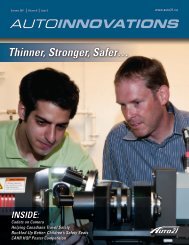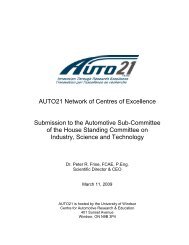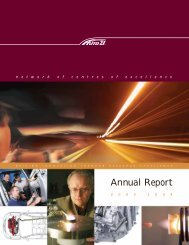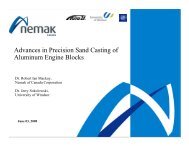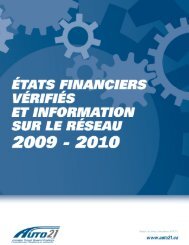Create successful ePaper yourself
Turn your PDF publications into a flip-book with our unique Google optimized e-Paper software.
explained the purpose of the study, invited the driver to participate and for thosedrivers who agreed, then directed them to the observation area. If the driverdeclined to be apart of the survey, the observer completed the non-participantsurvey form for the vehicle to identify gender of driver, belted status of driver,number /type/ restraint status of occupants. This data was collected by theinterceptor only for those drivers who declined to participate in the parking lotsurvey to ensure there would be no duplication of data entry on child occupantstatus.The Parking Lot Survey continued with a detailed inspection of child seatrestraint use and included a brief interview with the driver. Following the pilottesting of the survey protocol it was determined that a two member team couldmove through the parking lot data collection rapidly to minimize the time requiredof the driver to complete the data collection. One of the team members greetedthe driver in the observation station and obtained written consent for participationand ensure a copy of the consent was given to the driver. The second membertook down the first ten digits of the vehicle identification number (VIN) andrecorded the seating position and restraint use of each of the child occupants 14years of age or under. Height and weight measurements were completed foreach child occupant who was willing to participate in this component of thesurvey. Parents were asked to remove the child from the vehicle and observewhile the height and weight was measured. The data collection time to completeall the entries varied between 10 and 20 minutes depending on how manyoccupants were in the vehicle and how many questions parents asked observers.All data was recorded on a paper copy of the observation survey instrument.When the survey was completed the team provided a sticker for each child whohad participated and the driver was provided with Transport Canada Child Safetyinformation that corresponded to the car seat their child was using or shouldhave been using. In all cases, the data were obtained from the driver or adultoccupant. The survey was administered by a survey team of 8 pre-traineduniversity students or adults.Through teleconference, video taping, powerpoint presentations, and emailcommunication team leaders and their data collectors received 4 hours of paideducation and training prior to commencing the survey. Telephonecommunication was maintained between team leaders and the principalinvestigator throughout the data collection phase of the study. All decisionsregarding changes or unexpected events that occurred during data collectionwere made by the principal investigator to ensure consistency of surveyprocedures.2.4 InstrumentThe instruments used for this National Child Seat Survey were updated versionsof the survey instruments used in the 1997 survey. The roadside intersectionobservation survey tool was used in the same format it had been developed for7



